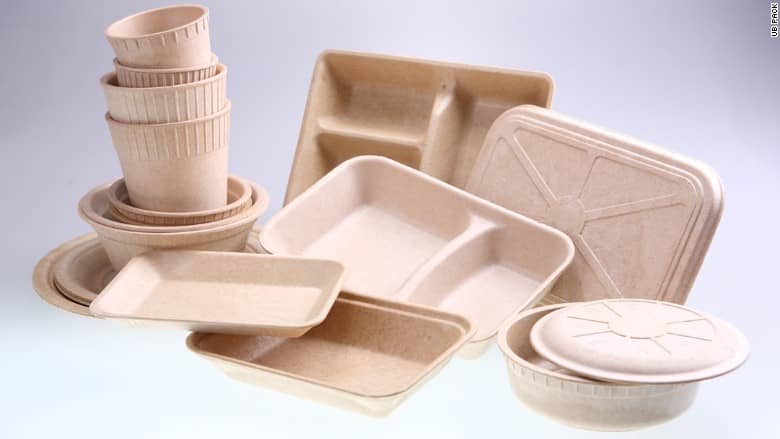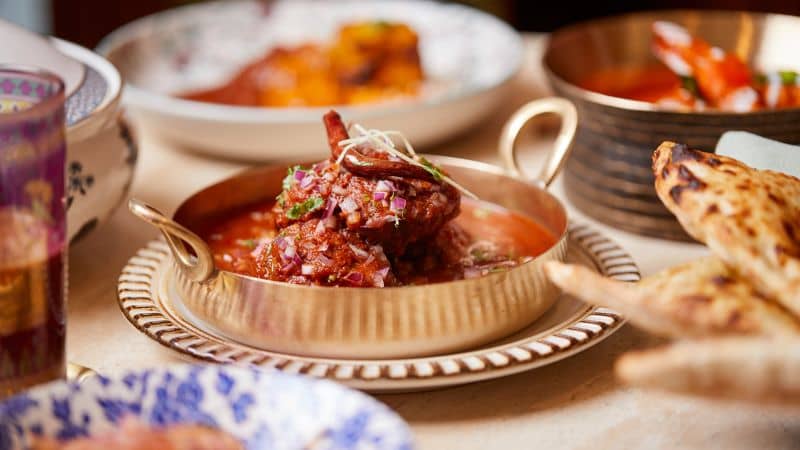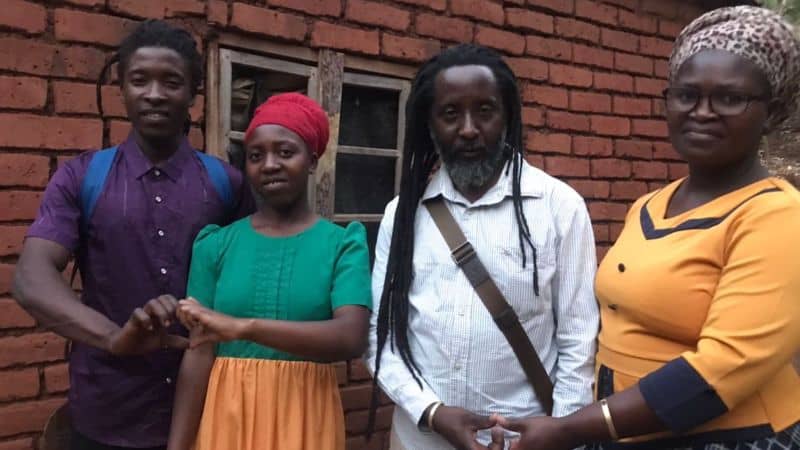Every episode is chock-full of mouthwatering regional specialties prepared by chefs all over the country. For those wanting to follow in Stanley Tucci‘s footsteps, below is an episode-by-episode guide to all the
This Italian icon suddenly looks different
Editor’s Note: Sign up to CNN Travel’s free nine-part Unlocking Italy newsletter for insider intel on Italy’s best loved destinations and lesser-known regions to plan your ultimate trip. Plus, we’ll get you in the mood before you go with movie suggestions, reading lists and recipes from Stanley Tucci.
CNN
—
For over 500 years, Michelangelo’s sculpture of David in Florence has stood unchanged, the marble icon of masculinity, and one of the world’s most famous works of art.
But as Italy emerges from the pandemic, the David has got a whole new look.
A new lighting system has revolutionized how the famous statue looks, with small details visible for the first time in its history.
“A few days ago, I noticed muscles on the body that I’d never seen before,” says Lucia Lazic, a guide who visits the Accademia Gallery most days.


Michelangelo’s David in the Accademia Gallery.
Emilio Fraile/NurPhoto/Getty Images/Guido Cozzi
“I said, ‘What on earth? How have I never seen this?’ The lighting is much better on the David.”
Cecilie Hollberg, director of the Accademia, said in a statement that the lighting has “changed the visual perception of the artworks,” telling CNN that the David’s marble looks “whiter” and that the details are “more visible.”
The lighting – completed in September as part of works that were unveiled this week – aimed to bring the “dynamism of sunlight” into the Tribuna room where the statue is kept under a domed skylight.
LED spotlights were installed in a circle above the statue, allowing them to “completely envelop the David and leave the rest of the space in the background.”
The color of the light changes imperceptibly during the day, while the spotlights are of varying warmth, allowing visitors to get a new perspective with every step around the statue.

The new-look David is part of a wider revamp of the museum, which was Italy’s second most visited in 2019.
The Galleria dei Prigioni, or “prisoners corridor” – named after Michelangelo’s four semi-finished sculptures of prisoners of war, which share the space with two of his other works – has also had its lighting switched up, with several spotlights pointed on each sculpture.
“It used to be that the prisoners looked yellow, and David was white. Now they’re the same color,” Hollberg told CNN.
“You can now see every chisel mark on them.”
The new lighting system, which “restores the right balance of chiaroscuro and color to the works,” is also energy-efficient. Hollberg says the gallery should use around 80% less electricity than in previous years.
It’s not just the headline works that are looking different. Several of the other rooms of the gallery have had their previously beige walls painted in colors that maximize those in the paintings.
The Sala del Colosso, the gallery’s first room, is now a bright blue, while the 13th and 14th-century rooms are a pale green, chosen to bring out the gold used in most of the paintings.


Sala Colosso in the Accademia Gallery
Guido Cozzi
And the new lighting everywhere has transformed the paintings from things tourists used to rush past en route to David, to unmissable in their own right.
“One regular visitor said, ‘Where was all this detail? We never saw it,’” Hollberg told CNN. “In one painting by Domenico Ghirlandaio you can now see all the gold dots in the [saints’] halos. Before, the beige walls flattened the gold. In another, it feels like you could pluck the pearls from the painting – before you couldn’t see them at all.
“My job is to give value and visibility to all the works. Every single work here is a masterpiece, but works die on a beige background – they need to be lifted and supported by color. I want to give them what they deserve.”

In the past, the lighting was so bad that some paintings were barely visible – like those beside the David. “Before it was all dark, you couldn’t see them – no one stopped,” said Hollberg. One time she saw a guide shining their phone torch on another painting in a bid to show it to visitors.
Tourists have already changed their behavior, she said.
“Now they stop and look. They’re not all in front of the David like before. I’ve followed groups, and they used to cut through the Sala del Colosso and never stop. Now I see that room full of visitors – it’s redistributing the crowds.”
Lazic, a guide with Elite Italian Experience, agrees: “There are more people stopping in the Sala del Colosso.”
The renovations, which started just before the pandemic and which have been rolled out this year, have finished with the revamp of the Gipsoteca. The plaster cast gallery was another rush-through place. That’s if it was open – with no open windows or air conditioning, it used to close at midday during the summer.
But now with air conditioning, powder blue walls and a new layout for the 414 plaster casts – mostly done by sculptor Lorenzo Bartolini, whose works are found in the Louvre, Amsterdam’s Rijksmuseum and the Metropolitan Museum of Art – it’s a place to linger.
Hollberg says that locals are starting to appreciate the museum, too. “Before it was a space for tourists, but Florentines are rediscovering it. We got the last resisters in with a concert series.”
Dario Franceschini, Italy’s minister of culture, called the reopening of the Gipsoteca “an important step… in bringing [the Accademia] into the 21st century.”
He added: “The works across the entire building have allowed significant innovations in the systems, transforming a museum conceived in the late 19th century into a modern venue without distorting it.”
Don't Miss
CNN — Ferrari’s miserable season has gone from bad to worse as the Italian manufacturer failed to get either car
To tackle Thailand’s mounting trash problem, one company is turning to the country’s plant life. Universal Biopack makes packaging that
CNN — Lewis Hamilton may be Formula One’s most successful driver but after securing a record-equaling seventh world title on
Sign up for Unlocking the World, CNN Travel’s weekly newsletter. Get news about destinations opening, inspiration for future adventures, plus the latest in aviation, food and drink, where to stay and other travel developments.
CNN
—
Japanese artist Yayoi Kusama’s famous yellow pumpkin sculpture was reinstalled on October 4th on Naoshima island after it was swept into the sea and badly damaged during a typhoon last summer.
Local residents, students and officials gathered to celebrate the art island’s trademark sculpture as it was placed back on the pier on Naoshima Island, which is in the Seto Inland Sea. It had been there since 1994.
“Since (the pumpkin) was a symbol of Naoshima, it is great to see the same artwork installed again at the same spot. We are happy to share the joy with residents in Naoshima,” said Yukari Stenlund, a spokeswoman from Benesse Holdings, the company that manages the sculpture and the rest of the island’s art offerings, told CNN Travel.
The sculpture, which is two meters tall, 2.5 meters wide and made of fiberglass-reinforced plastic, was swept away into the sea and broken into three pieces in August 2021.
According to Stenlund, Kusama’s production team opted to create a brand new yellow pumpkin sculpture – while staying true to the original – after evaluating the extent of the damage.

The artist’s production team started working on a new pumpkin earlier this spring and made the sculpture’s outer shell 10% thicker than the original so it could withstand strong waves and wind in the future. In addition, a hook was embedded into its stem so it could be easily dragged to safety if another typhoon hits.
“We hope to exhibit the pumpkin as a symbol of the connection between Naoshima and the world,” Stenlund added, saying that message underpinned the 1994 “Out of Bounds” exhibition, which saw the sculpture first installed on the island.

Naoshima: Japan’s ‘art island’
Naoshima is a quiet with 3,200 residents, located in the Setouchi Sea, north of Shikoku. With three modern and contemporary art museums, it is known as an “art island,” The yellow pumpkin, which contrasts with the blue sea, has long been a popular site for Instagram photos.
The main way to access the island is a 20-minute ferry ride from Okayama city, which is 50 minutes away by bullet train from Osaka.
The pumpkin’s timing couldn’t be better. Japan opens its borders to leisure tourists on October 11, and the Setouchi Art festival runs until November 2022.
Don't Miss
CNN — Paul Templer was living his best life. He was 28 and conducting tours in his native Zimbabwe, with
CNN — Coco Gauff was ruthless and totally dominant in her US Open quarterfinal against Jelena Ostapenko, dropping just two
CNN — The escalating climate crisis is shifting many people’s purchasing patterns and this extends to the $500 billion dollar
CNN
—
Rachel Décoste landed in West Africa’s Republic of Benin in August 2018, anticipating an important journey of self-discovery, but not predicting the extent to which the trip would change her life.
On her first day exploring Benin, Rachel asked a passerby for directions. Two weeks later, Rachel and the stranger were engaged. Within six months, they were married.
Rachel grew up in Ottawa, Canada, the daughter of Haitian parents who’d immigrated to Canada in the late 1960s. As an adult, Rachel relocated to Washington DC for college, later working for a bipartisan tech program associated with the United States Congress.
Rachel loved this job, she loved the diversity of Washington and loved working in public service. When her US visa was up for renewal, Rachel, then in her early 40s, figured she’d work remotely for a few months before returning to DC.
But rather than working from Canada, she hatched a plan to set up her desk further afield.
Earlier that year, Rachel had submitted her DNA to an online ancestry site. Rachel had long known she was the descendent of enslaved Africans, but until she got the results, she hadn’t known where her forebears had lived. Now, she had a list of countries where she had roots: Senegal, Ivory Coast, Togo, Ghana and Benin.
“DNA tests for a descendant of enslaved Africans has very deep significance for us,” Rachel tells CNN Travel. “Even though it’s not a precise science, when you get the map of where your ancestors came from, it’s an emotional journey.”
Rachel arrived in Benin towards the end of her five month remote working trip. She’d already visited the other countries on her list, and her African trip was shaping up to be an extraordinary journey of self-discovery. Nevertheless, Rachel didn’t know what to expect from Benin.
“Honestly, I don’t know if I could find Benin Republic on a map before this,” she says.
She booked a room in a bed and breakfast in the port city of Cotonou, planning to stay there for two weeks – working from the B&B and exploring the country in her spare time.
Following a couple of days settling in, Rachel ventured out for the first time. She planned to visit Ouidah, once one of the most active slave trading ports in Africa. She expected this would be a moving and thought-provoking experience.
“I’m sure that one of my ancestors passed by there, just because of my DNA test,” says Rachel.
Exiting her room, Rachel searched around for the manager of her bed and breakfast – she was looking for guidance on how best to travel to Ouidah.
“She’s nowhere to be found. And then I look for the security guard, and the security guard is on break.”
Rachel figured her next best bet was asking a passerby outside, so she opened the gates and glanced around.
The first person she spotted was a man about to get on a motorcycle, parked just outside.
Rachel greeted the stranger in French – as a French Canadian, French is her first language and it’s also the official language of Benin – and politely asked him how to get to Ouidah.
“You have to go to a certain intersection downtown, where all the bush taxis are,” explained the stranger. “You find the taxi going to your destination, you pay for your seat, and then you’ll get there.”
He started passing on directions to the intersection, but then, realizing they were a bit complicated, changed his tune.
“If you want. I can bring you there, it’s about 10 minutes away,” he suggested, gesturing to his bike.
It was about 9 a.m. Rachel was wary of trusting someone she didn’t know, but she decided she was unlikely to come to harm in broad daylight. She agreed.
“I take a chance, hop on the back of his motorcycle, no helmet,” she recalls.

The motorbike-riding stranger was Honoré Orogbo, a single father and business owner in his thirties who’d lived in Cotonou all his life and just happened to be passing by that morning.
When Rachel opened the bed and breakfast door, Honoré had just finished eating some breakfast he’d grabbed from a nearby street kiosk.
From the outside, Rachel’s accommodation wasn’t obviously a B&B. Honoré says he assumed she was the owner of the house. It was only when she asked for directions that Honoré realized Rachel was a visitor.
When Rachel and Honoré arrived at the taxi rank in Cotonou city center, they realized the one heading to Ouidah was pretty empty. Honoré explained it would be some time before it departed – the driver wouldn’t leave until the taxi was full.
Rachel was disheartened. She didn’t have time to wait around – she wanted to spend the whole day in Ouidah without feeling rushed, and to safely return to Cotonou before sundown.
Sensing her disappointment, Honoré came up with a suggestion. He had a friend in Ouidah he’d been hoping to visit – while he hadn’t been planning to go that day, he could, he had a day off.
“I’m like ‘Cool. I’ll pay for gas. Let’s go,’” recalls Rachel.
Just over an hour later, they arrived in Ouidah.
“He shows me how to get back – where the bush taxis are that I can get back that afternoon – and he shows me where the Slave Museum is. And I’m like, ‘Okay, good to go. Thanks, sir,’” recalls Rachel.
But before they were due to go their separate ways, Rachel asked Honoré if he wanted to get brunch. She wanted a bite to eat before she started her tour – and extending the invite to Honoré felt like the polite choice, he’d gone out of his way to help her, after all.
Honoré agreed, touched by the gesture. The two sat down to eat.
Rachel was aware that she was a woman traveling alone, and while Honoré had been nothing but polite and respectful, he was still a stranger, so she told him she was married.
She also didn’t share details of her job, or her life in the US. But she did explain how she was hoping to travel around Benin over the coming days. She asked Honoré if he had any friends or contacts who worked as chauffeurs or tour guides, and who might be interested in escorting her around over the next couple of days. She figured that might be easier than relying on taxis.
Honoré contacted a tour guide friend, but he was fully booked
“So I said, ‘Well, how about you? Can you be my escort? You helped me out this morning, can I just pay you to do that for three days?’” recalls Rachel.
“No, I’m not a I’m not a tour guide,” said Honoré. “I don’t know my country’s history by heart, and that’s not what I do.”
Rachel backtracked. She didn’t really need a tour guide – there would be experts at all the historical sites she planned to visit – she just needed a ride.
After a bit of back and forth, Honoré agreed to drive Rachel.
“When she insisted, I said ‘Why not?’” Honoré recalls today.
He wanted to help Rachel, Honoré says. She seemed like a “good person,” based on the way she’d approached him, the way she’d asked him questions and the way she’d invited him to brunch.
The two agreed Honoré would drive Rachel around for the next few days, starting that day in Ouidah, and Rachel would pay him for his services.

For the rest of the week, Honoré took Rachel to Benin’s most important sites.
Touring Benin was a powerful experience for Rachel. She says visiting the slave fort, inside Ouidah’s Museum of History, “is a pilgrimage that every afro-descendant should visit to remind us of the cruelty that our ancestors survived.”
“I didn’t know this before going there in person, but if Las Vegas was taking bets on the survival of enslaved Africans, the odds of my being alive today would have been slim to none,” says Rachel. “I am a walking, talking miracle. I am the ‘one percent.’ I owe it to those who didn’t make it to live my best life.”
While traveling around Benin, Rachel and Honoré talked. While Rachel still didn’t disclose many details about her personal circumstances, but she found herself opening up to Honoré about her thoughts and feelings. Honoré opened up in turn.
“First conversations were about learning about myself, my family, my situation, who I am, who I really am,” he says.
“We were very open and very candid, because we were strangers and we’ll never see each other again,” recalls Rachel.
She remembers being touched when Honoré explained that he didn’t have a new model of motorcycle because he put all his money towards his son’s education.
“He says ‘I’d rather have my kid have those opportunities than drive a fancy motorcycle.’ And I thought, ‘Wow, those are the values of my parents.’ I saw myself in those values,” says Rachel.
In one of their many conversations, Honoré mentioned his brother was a tailor. On their fourth day together, Honoré took Rachel to a market to help her buy fabric that his brother could make into a dress.
Rachel was overwhelmed by the choice – so much so that she asked Honoré to pick his favorites. He opted for two pieces of colorful, bright Ankara fabric. The third option was a white, gray, lace style, called lessi. Rachel loved it, and figured the resulting dress could be “appropriate for a baptism or some kind of special occasion.”

In one of their many conversations driving to Benin landmarks, Honoré mentioned to Rachel that he would usually travel to Lomé, the capital of the neighboring country of Togo, when he and his friends wanted a night out.
Rachel was intrigued.
“I can’t guarantee that I’ll ever come back here. This is a once in a lifetime trip where I’m getting paid while I’m working in a foreign country. I want to take advantage of every opportunity,” she remembers thinking.
“So I said, ‘Well, I have to go back to work this week. But next weekend, if you’re willing, I could get two hotel rooms and we could go to Togo together.”
The following weekend, Honoré took Rachel to a poetry slam night in Lomé, followed by a bar with live music. They stayed out all night.
“We’re dancing. It’s just pure joy,” says Rachel.
It was around this time that Rachel started to feel things shift. She felt comfortable around Honoré in a way she’d never felt before.
“We get along great. He laughs at my jokes,” she recalls thinking. “I had a bit of a meltdown a couple times – which I’m not proud of – where he didn’t freak out, because usually angry Black women scare people. But he took it all in his stride.”
Rachel even briefly met Honoré’s son.

She described the situation in an email to one of her close friends back in Ottawa.
“I think I think this person should be my husband. But am I crazy? I’ve known this guy for a week. Is that stupid? Tell me if I’m crazy,” she wrote.
Her friend wrote back: “Rachel, you are not a stupid person. You have good judgment. You are a good judge of character. If he’s the one, grab him.”
For Honoré, the trip to Togo was a turning point too.
“I think it’s that night that the lightning struck,” he says. “It was not lightning but it was a feeling of love. I think that’s where the feeling of love started.”
Rachel only had one more week in Benin before she was set to return to North America. She decided she had no time to waste.
“I told him that I really wasn’t married. And he was very happy to hear that. And we got together,” she says.
“I was kind of surprised,” says Honoré now. “I thought a woman like that would probably have a husband.”
“Next day I saw her differently,” he adds. “Not like a tourist but my soulmate. That’s how the relationship started. Step by step.”
For the remainder of Rachel’s time in Benin, Rachel and Honoré spent as much time together as they could.

On the evening of Rachel’s departure, Honoré recalls sitting with her on a beach. He was enjoying the moment, but also considering Rachel’s impending return to Canada, and what it meant for their burgeoning romance.
“We were facing the ocean. In my head, I was thinking ‘the past two weeks that I’ve spent with you, I have no regrets. We had a great time together. I was really happy to meet you.’”
The two talked about the future, and if and how they could make a long distance relationship work. They realized they were both equally committed, and so they decided to get engaged, and that Honoré would relocate to North America.
It was a big decision. They’d only known one another for a couple of weeks. And for Honoré, emigrating had never been a goal. It would be a big change for his son. But Honoré says he decided to “follow my instincts, to follow my heart.”
Meanwhile, Rachel quit her life in DC, and went back to Canada. Rachel says her friends were shocked, but supportive and happy when she told them about the whirlwind romance. Her parents were more skeptical, she says. But they came round when they met Honoré, and saw how in love he was with their daughter.
Rachel returned to Benin six months later, in January 2019, for her wedding to Honoré. She wore the dress made from the white lace fabric Honoré had picked for her in the market the summer before. It felt like fate.

Meanwhile, the couple planned a Canadian wedding celebration for the following year, navigating Honoré and his son’s immigration journey in the meantime.
“I took the time during the separation to start preparing myself mentally and psychologically for a big move,” recalls Honoré. “I had to think about the huge life change that was going to be ahead of me, the cultural differences. I know people who went to the Americas and it wasn’t necessarily easy.”
Honoré also prepared his child for the move.
“I explained to him that, ‘My son, we will go to a different country and we will start over together. With time, you will have new friends, you will have new cousins. You will have everything you wish for. everything that you have here you will have over there, in time.”

Honoré and his son arrived in Canada in the middle of winter.
“It was really really really cold,” he recalls. “I just didn’t understand how cold it could be outside. Because the cold of Africa is a whole different kettle of fish, than the cold in Canada.”
Still, once Honoré was kitted out with Canada-appropriate boots, coat and mittens, he started adapting to life in a new country.
Rachel and Honoré say they were over the moon to be together. The months apart waiting for Honoré’s visa approval had been long.
Honoré’s son settled in very quickly, and Rachel adapted to becoming his stepmother, a role she says she loves.
“I’m embracing the challenge and the joys of motherhood,” she says now.
“It’s not easy when you’ve been single since forever to adjust to having to share your life. But he’s a good kid.”
Today, Honoré and Rachel live in Ottawa. Rachel works as a diversity and inclusion expert, while Honoré is studying.
Rachel also recounted her experiences traveling Africa in 2018, including meeting Honoré, in an audiobook called “Year of Return: a Black Woman’s African Homecoming.”

Rachel and Honoré are also bringing up their son together, and run a business selling warm, Canada-winter-appropriate pajamas with African prints, called Woke Apparel.
The pandemic put a stop to their big Canadian wedding celebration plans, but they enjoyed a small ceremony in summer 2020.
Reflecting on their journey together, Honoré says their story makes him consider that “sometimes you shouldn’t force fate.”
He sees meeting Rachel as “destiny” but considers moving across the world to be with her as proof of the importance of trusting your gut.
“Just follow your heart,” he says. “Follow your heart with reckless abandon.”
As for Rachel, she says their love story is a reminder to her that “it’s never too late.”
“You’re not too old to just travel alone by yourself, in a country that you don’t know, where you don’t know anybody. You’re never too old to find love. You’re never too old to become a mother.
There is no expiration date on opportunity. And grab life by both hands. If I can do it. You can.”
CNN
—
Hong Kong is widely considered one of the most challenging cities in the world to operate a restaurant – a roiling cauldron of changing tastes, cleaver-sharp competition and unsavory economics.
Right at the heart of its culinary world, with connections to at least half of its hottest tables, is publicist Geoffrey Wu.
Wu and his 10-year-old consultancy firm The Forks and Spoons work with some of the most decorated restaurants and bars in town, such as the two-Michelin starred TATE Dining Room and Ando, one of the most sought-after reservations in town.

“I wouldn’t say we’re better at our job than other people. I’d say we’re different,” he tells CNN Travel in The Baker and The Bottleman, a new casual bakery and natural wine bar by celebrity British chef Simon Rogan, where he’s agreed to spill some of the secrets of Hong Kong’s dining scene.
After being expelled from the University of Science and Technology in Hong Kong for “skipping too many classes to play cards at McDonald’s,” Wu joined Amber, the famed French restaurant under the helm of Richard Ekkebus, as operations staff in 2005.
Over the next few years he took on various marketing roles for different companies – but always found himself back in the food and beverage industry. In 2012, he opened his F&B consultancy firm.
Wu isn’t your typical food and beverage publicist. He isn’t congenial. He’s known for occasionally yelling at clients for making a mistake, or members of the media he feels haven’t done their research.
“I am not afraid to speak up – people know that for sure. Sometimes you need a consultant who is straightforward about things that must be fixed. We aren’t here to massage your ego. We are here for the results. We are here to win,” says Wu, sounding more like a football coach than a PR professional.
“If I wanted to please everyone, I’d go sell ice cream. Luckily, most of my clients understand.”
Among these clients is Yenn Wong, founder and chief executive officer of JIA, a restaurant group behind popular award-winning Hong Kong eateries like Mono and Duddell’s.
“The Forks and Spoons understand and personalize the needs of each concept and is always staying very current with the relevant strategies to ensure we as clients get the most publicity to our target audience, which ultimately delivers positive revenue growth,” Wong tells CNN Travel.
‘The most cutthroat F&B market in the world’
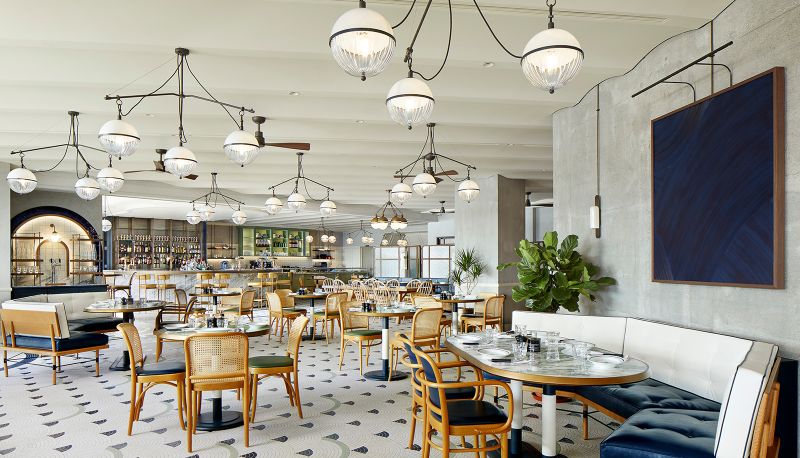
One of the important duties for a F&B publicist is to be physically present at a restaurant, according to Wu. He is either tinkering with menus, sampling new dishes or simply meeting with clients.
It could be anything from translating the restaurant’s a la carte menu from Chinese into English to working with chefs on choosing dishes for a tasting menu, “so you can see what’s happening and let the staff know that you care,” says Wu.
For instance, later that day, he says he’s having a trial lunch at Bluhouse, a new casual Italian dining concept at the Rosewood Hotel in Kowloon.
“At a tasting, we’ll look at everything – taste, presentation and temperature of the food. We also look at furniture, operation flow, pricing, etc.,” he says. “No new restaurant is ever perfect, but let’s try to minimize the error.
“We have only worked with clients in Asia – Hong Kong, Macao, Maldives, etc – but I really believe that Hong Kong is the most cutthroat food and beverage market in the world.”
His claim isn’t baseless.
Getting the opening right is essential in Hong Kong due to its competitiveness.
The city is frequently named as the world’s most expensive rental location. And Hong Kong residents are some of – if not the – biggest spenders on dining out, especially pre-Covid. Food imports are extremely expensive.
According to a recent government survey, Hong Kong households spent an average of HKD60,539 (or US$7,761) on meals out and takeaway food in the year of 2019 to 2020 – Hong Kong suffered from half a year of social unrest in 2019 before the outbreak of Covid in 2020
That was about double what New York-area household spent on average on food away from home during the same year.
“It’s such a condensed market,” says Wu.
“People always talk. Hong Kong customers are also very knowledgeable. If you don’t get it right from the get-go, you have to revamp many things. The question is – will the customers give you a second chance? There are so many choices that chances are they’d go somewhere else.
“So to build a successful restaurant, it’s important to make sure the opening is a strong one. With good word of mouth then businesses will come. It’s that simple.”
Case in point: Bluhouse. It opened in June and dinner reservations are full through October and November at the time of the writing.
Hong Kong’s F&B industry has evolved rapidly in the last decade, thanks in part to the arrival of Michelin Guide in 2009 as well as the rise of social media and the local food community.
Chefs in Hong Kong have experienced a shift in their roles.
“Some 20 years ago, chefs mostly just cooked and served food,” says Wu.
“Now in 2022, there is also this thing called relationship building. Chefs have to show their faces. They have to touch the tables and to take pictures with guests. The job of a chef is much bigger than before. It all goes back to a need for human connection. Customers, media, influencers, bloggers – everyone wants to have a human connection.”
And it just makes good business sense – guests are more likely to return to a restaurant where they have established a relationship with the chef.
The problem, of course, is that chatting with diners doesn’t come naturally to all chefs. That’s where Wu comes in.
“We just encourage and encourage and encourage them,” he says.
He cites Manav Tuli of modern Indian restaurant Chaat – which is also located at the Rosewood – as a success story. Chaat opened in 2020 and won its first Michelin star two years later.
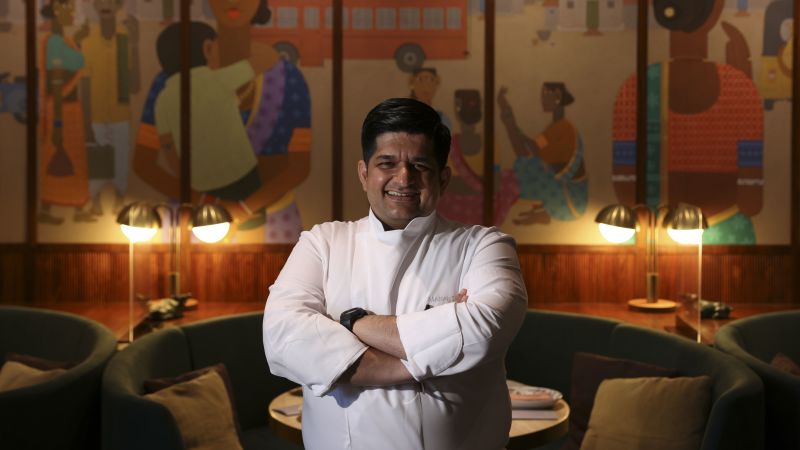
Unique dishes like Tuli’s showstopping tandoori lobster – Indian food with a Hong Kong seafood twist – and a team of knowledgeable staff which communicates the stories of the food beautifully are some of the reasons Chaat is one of Hong Kong’s hardest to book restaurants.
Tables are released two months in advance and swept up in minutes.
But the biggest star of Chaat is Tuli, considered one of the city’s most beloved culinary figures right now.
“When he arrived two years ago, he didn’t know the landscape or culture of Hong Kong,” said Wu. “He is a quiet person but we align in a certain way as we both have a drive. For him, moving his family to Hong Kong with him, he wants to make this a success. So we have been working very closely since day one on that,” said Wu.
He encouraged Tuli to meet the guests and fellow chefs, joining him at events and meals as the chef built a name for himself.
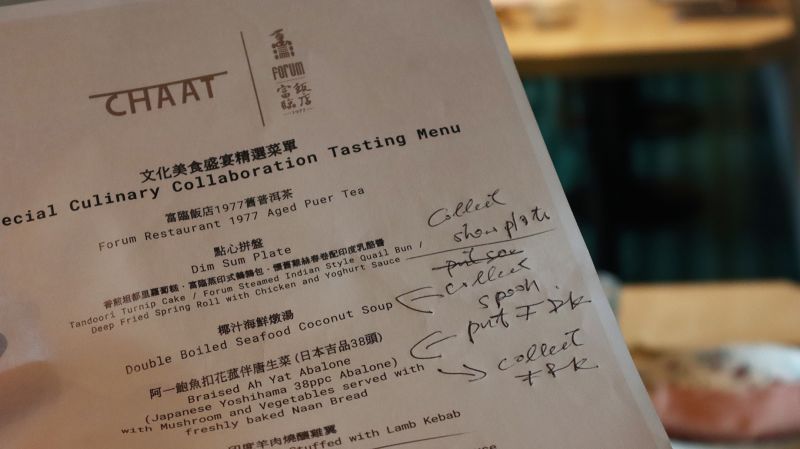
On his days off, Wu organizes lunches for media, including revered industry critics, and chefs he works with or may work with in the future.
These often take place at venues Wu doesn’t work for, from Hop Sze, a no-frills Cantonese diner that has a six-month wait list, to the Forum Restaurant, a Chinese joint with three Michelin stars.
“I worked til 4 a.m [this morning]. I only joined because Geoffrey Wu arranged this lunch,” one food critic tells CNN Travel as he enters the private dining room inside Forum.
The menu of the day includes all kinds of dishes – from street food-style rice rolls to classic Cantonese sweet and sour pork and the restaurant’s famous braised abalone.
As with most lunches with Wu, there’s also an off-menu surprise.
Adam Wong, the executive chef, and CK Poon, the general manager, come in with a pushcart near the end of the meal.
“We are thinking of adding this to the next menu update,” says Poon as he caramelizes sugar for the candied apple fritter (ba si apple), a Northern Chinese-style dessert, on-site.”It’s the first time we’re doing this – so let us know what you think.”
The five-hour lunch wraps up with industry gossip over bottles of cognac.
But Wu is never not working.
He punctuates gatherings with potential collaboration ideas (Tuli and Wong exchanged ideas that day on a hookup between the two restaurants), and fills in moments of silence with jokes to keep the meal entertaining.
“I always say that I’m the chief entertainment officer,” says Wu. “Building relationships takes time. Cold-calling and sending press releases aren’t building a relationship.”

At the end of the day, connections won’t get you far if the food isn’t good or the restaurant refuses to evolve.
“Flavor doesn’t lie,” says Wu. “But everything – restaurants, bars, chefs – has a shelf life. It’s impossible to stay number one forever. You need to keep coming up with new ideas to continue to elevate the restaurant.”
It could be doing more tableside services, educating guests about the dishes, or simply adding a pre-dessert bite that cleanses the palate, he says.
One of Wu’s latest tasks is to edit the menu at one of his new clients, Yong Fu, a Michelin-starred restaurant that specializes in high-end cuisine from China’s east coast Ningbo region.
He’d like to trim down the original one-inch-thick book and has created a tasting menu to offer a more curated ordering experience.
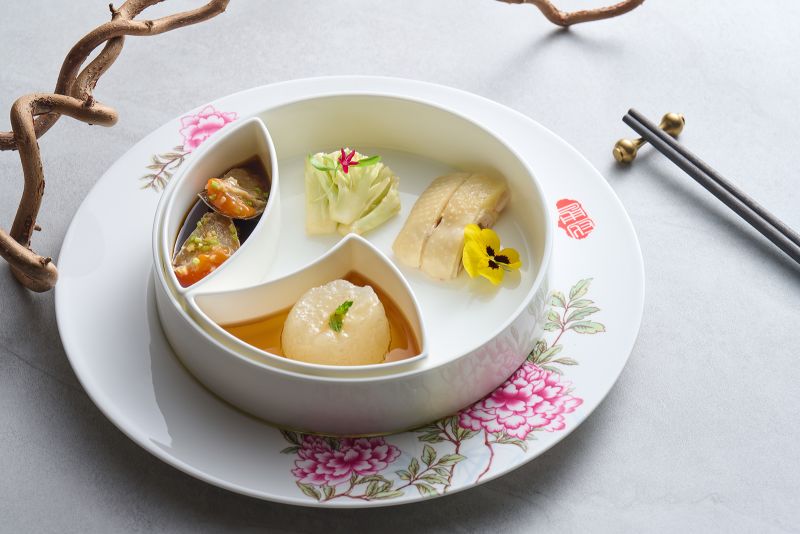
In Hong Kong, Ningbo cuisine is often confused with Shanghai cuisine. The tasting menu includes dishes that diners may not know enough about to order – a “sticky” boiled wax gourd and yellow croaker fish in sour broth, for example – that amplify the trinity of Ningbo cuisine’s star flavors: “savory, umami and sticky.”
Yu Qiong, Yong Fu’s manager, is there to offer an in-depth explanation on each of the dishes.
“These are some of the things that will enrich the whole dining experience,” says Wu. He compares marketing restaurants with running: “Keep refining. Keep pushing. My belief is, just don’t stop until you are at the finishing line.”
It’s an apt metaphor. The avid runner wakes up at 5:45 a.m. on most days to fit in exercise.
“I enjoy Hong Kong on quiet mornings when the city hasn’t woken up yet. When you run, you see a lot of things and think about a lot of things,” says Wu.
As for what was on his mind that particular morning?
“I was thinking about our interview. I was thinking about not swearing. I did well – I only swore once.”
Don't Miss
Digital Brief: Dec. 3, 2022 (AM) Digital Brief: Dec. 3, 2022 (AM) 02:59 BRICK, N.J. (CBS) — Two people in
CNN — For years, Alli Nansolo grappled with whether to cut his son’s dreadlocks or not. Although it is not
To tackle Thailand’s mounting trash problem, one company is turning to the country’s plant life. Universal Biopack makes packaging that
Editor’s Note: Monthly Ticket is a CNN Travel series that spotlights some of the most fascinating topics in the travel world. In October, we shift our focus to the offbeat, highlighting everything from (allegedly) haunted spaces to abandoned places.
CNN
—
In March 2022, the world let out a collective gasp when the remarkably preserved shipwreck of Ernest Shackleton’s HMS Endurance was discovered almost two miles beneath the icy Antarctic seas.
But scores more sunken vessels remain on the ocean floor, awaiting rediscovery.
Here are some of the world’s most infamously elusive shipwrecks, plus a few you can see for yourself (some without even getting wet).
A lowly cabin boy shouldered the blame for the sinking of Christopher Columbus’ Santa Maria flagship off the coast of Haiti on Christmas Eve 1492. The inexperienced sailor is said to have taken the wheel after Columbus went for a nap, and shortly after wrote off the ship by crashing it into a coral reef.
That’s one theory, anyway. However the Italian explorer’s ship met its fate, excitement bubbled over in May 2014, when archaeologist Barry Clifford claimed he’d chanced upon its long-lost wreck.
Maritime history buffs’ hearts sank after UNESCO poured cold water on the claim, saying the ship that’d been found was from a much later period.
The Santa Maria is still down there, somewhere.
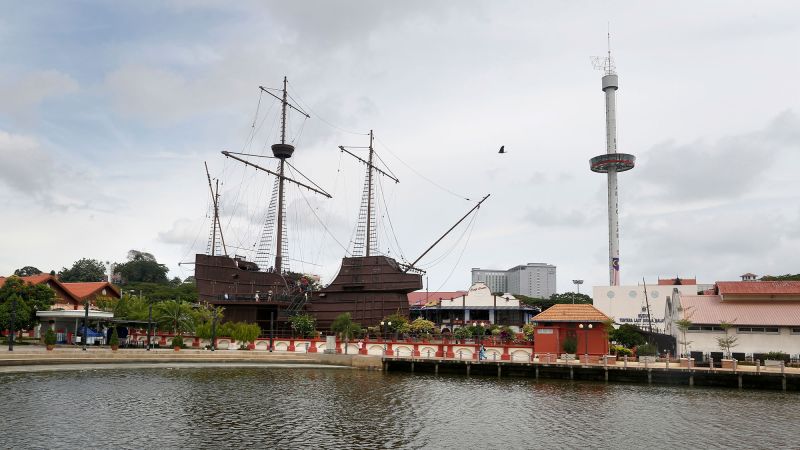
This 16th-century merchant ship – or “carrack” – shuttled between India and its home in Portugal. But given its mammoth size – 118 feet-long and 111-feet-high – it was an unwieldy beast to captain.
Perhaps it was only a matter of time before the Flor de la Mar went down, which it did in a heavy storm off Sumatra, Indonesia in 1511.
Most of the crew perished, and its booty – said to include the entire personal fortune of a Portuguese governor, worth a cool $2.6 billion in today’s money – was lost.
Recently, a fictionalized version of the pirate Zheng Yi Sao went in search of the treasure on an episode of British sci-fi series “Doctor Who,” only to unleash the dreaded Sea Devils.
It may not have its own theme song sung by Celine Dion, but the SS Waratah is known as “Australia’s Titanic” – and for good reason.
A passenger cargo ship built to travel between Europe and Australia with a stopover in Africa, the Waratah disappeared shortly after steaming off from the city of Durban in present-day South Africa in 1909 – just three years before the Titanic tragedy. As for the cause, theories abound.
The entire liner, complete with eight staterooms, music lounge and all 211 passengers and crew, was never found. Ninety years after the Waratah went down, the National Underwater and Marine Agency thought they’d finally found it, but it was a false alarm.
Said the late thriller writer Clive Cussler, who spent much of his life searching for the wreck, “I guess she is going to continue to be elusive a while longer.”
Rotten Tomatoes’ “Tomatometer” might rack up a rancid 17% for the 2016 Nicolas Cage movie, “USS Indianapolis: Men of Courage,” but in real life, the ship played a game-ending role in World War II.
The Indianapolis was chosen to transport the uranium core of the “Little Boy” nuclear bomb to Tinian Island, where the weapon was assembled shortly before being used to devastating effect on Hiroshima.
The drop-off of the deadly cargo went without a hitch, but on its return journey, the Indianapolis was hit by a Japanese sub, with many crew members perishing from shark attacks and salt poisoning.
The exact whereabouts of the warship remained a mystery for decades, but was finally located by a team led by Microsoft co-founder Paul Allen, in 2017 – 18,000 feet below the surface of the Pacific.
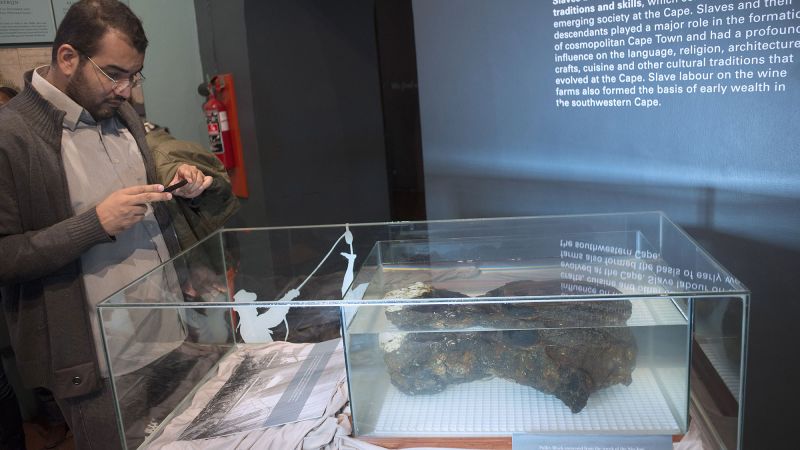
Not just one shipwreck, but an entire ghastly genre of them.
It’s estimated some 1,000 ships now on the bottom of the ocean were complicit in the wicked “triangular trade” across the Atlantic that saw some 12-13 million Africans forced into slavery.
Many of these ships sank in turbulent weather, such as the São José, which went down off the coast of South Africa in 1794.
Others, like the Clotilda, were purposefully scuttled by their owners, to cover up evidence of slave trading, long after the 1807 Act Prohibiting Importation of Slaves.
The wrecks of both these vessels have now been located – the São José thanks to the work of Diving With a Purpose (DWP), a group of largely Black scuba divers who dive on the sites of sunken slave ships, and bring the likes of rusted manacles and iron ballasts to the surface.
It’s impossible to retrieve such objects without also dredging up stories of human suffering, although DWP’s goal is to document slavery’s nefarious legacy, using it to educate and enlighten.
Still, such ships are notoriously elusive, and many may never see the light of day again.
Mehmed Çakir was diving for sponges off the coast of Yalıkavak, Turkey in 1982, when he happened upon the remains of a trading ship that had sunk here some 3,000 years previous.
His was the first of many dives – over 22,400 in fact – to bring up the long-lost treasures of the Uluburun, and what a haul it was; 10 tons of copper ingots; 70,000 glass and faience beads; olive oil and pomegranates stored in Cypriot pottery jars.
Some of the horde can now be seen at the Bodrum Museum of Underwater Archaeology, and while not much of the Bronze Age wreck survives, there’s a cross section reconstruction, which gives a feel for how it would have been stacked with all those goods, all those centuries ago.
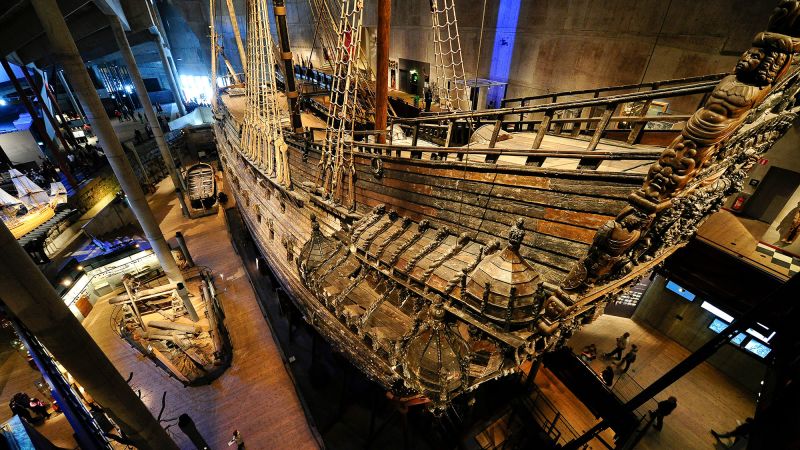
Eerily intact, the 17th century warship Vasa looks more like a prop from the “Pirates of the Caribbean” franchise, than a ship that first (and last) set sail in 1628.
The Swedish behemoth made it about 1,300 meters out of port before it went down, and was only pulled from its silty grave some 333 years later.
A crew of archaeologists (who took typhoid and tetanus jabs to protect themselves from various bacterias) discovered a hull bristling with 700 sculptures and decorations of mermaids, lions and Biblical figures – what has been described as essentially a “gigantic billboard for Sweden and Gustav II Adolf,” the country’s redoubtable king of the time.
Since a dedicated museum opened in Stockholm in 1990, the Vasa has become one of the world’s least elusive shipwrecks, ogled so far by some 25 million visitors.
Spied from the banks of the River Clyde at Greenock in Scotland, you might mistake the wreck of the MV Captayannis for a recently demised whale.
The black hull of this Greek sugar-carrying boat, rolled onto its side, is a favorite perch for feathered residents of a nearby bird sanctuary – and has been, since the ship went down in a squall in January 1974.
It’s said no one took responsibility for the so-called “sugar boat,” hence why it’s still wedged into a sandbank – a gauche reminder of the sea’s capriciousness.
Still, it’s a blessing for local boat charters like Wreckspeditions, who’ll take maritime rubberneckers up close, while pouring them a hot chocolate.
If scuba diving is what floats your boat, chances are you’ve heard of Chuuk Lagoon.
On this sprinkling of islands 1,000 miles northeast of Papua New Guinea, the Japanese set up their most formidable World War II naval base – that is, until Operation Hailstone was launched in 1944, with Allied forces sending some 60 Japanese ships and aircraft to a watery grave.
With most of them still down there, Chuuk Lagoon has become a mawkish subaquatic museum for divers to gawk at barnacled tanks from the San Francisco Maru or the long-abandoned compass and engine telegraphs of the Nippo Maru.
MS World Discoverer, Solomon Islands
“Open 24 hours” declares Google Maps optimistically about the shipwreck of the MS World Discoverer.
Since the cruise ship MS World Discoverer struck something hard, and half-sank off the shores of Roderick Bay in the Solomon Islands in 2000, it’s become a tourist attraction for passing ships (all passengers, it should be pointed out, were helped to safety).
Gently rusting away, at a 46-degree list, the ship looks like it turned on its side, and went to sleep. If nothing else, it’ll have you counting the lifeboats on your own vessel as you sail by.
Don't Miss
CNN — If you’re a parent, heading out the door before a car ride with the kids probably goes a
Editor’s Note: This story was originally published in April 2023. CNN — Slumped on his club, head buried in his
CNN — Lewis Hamilton may be Formula One’s most successful driver but after securing a record-equaling seventh world title on
20 best German foods | CNN
CNN
—
German food is rich, hearty and diverse. It’s comfort eating with high-quality, often locally sourced ingredients.
The cuisine of Germany has been shaped not only by the country’s agricultural traditions but by the many immigrants that have made the country home over the centuries.
It’s definitely more than a mere mix of beer, sauerkraut and sausage.
Today Germans appreciate well-prepared, well-served meals as much as they do a quick bite on the go. This is a country of food markets, beer gardens, wine festivals, food museums and high-end restaurants.
So: Haben sie hunger? Are you hungry now? Check out our list of 20 traditional German dishes that you need to try when you travel there.
Named after the former East Prussian capital of Königsberg (now Kaliningrad in Russia), this tasty dish of meatballs in a creamy white sauce with capers is beloved by grandmothers and chefs alike.
The meatballs are traditionally made with minced veal, onion, eggs, anchovies, pepper and other spices. The sauce’s capers and lemon juice give this filling comfort food a surprisingly elegant finish.
In the German Democratic Republic, officials renamed the dish kochklopse (boiled meatballs) to avoid any reference to its namesake, which had been annexed by the Soviet Union. Today it’s possible to find königsberger klopse under their traditional name in most German restaurants, but they are especially popular in Berlin and Brandenburg.
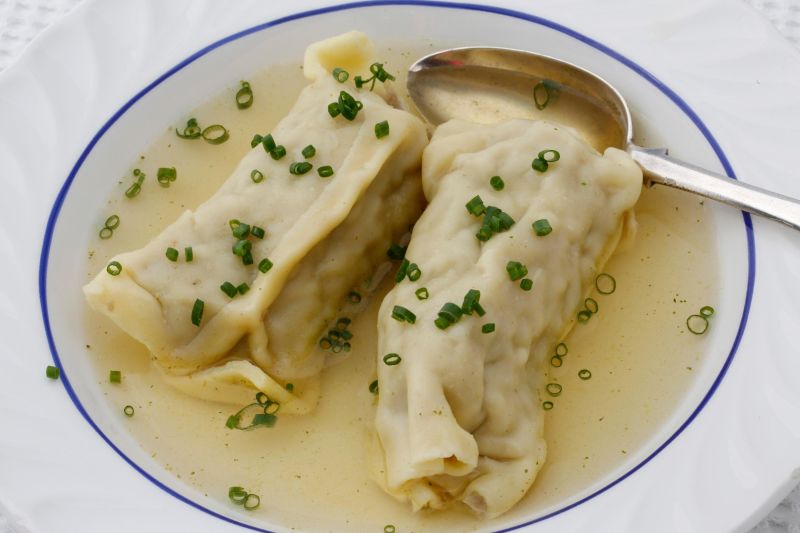
Maultaschen from Swabia, southwestern Germany, are a lot like ravioli but bigger. They are typically palm-sized, square pockets of dough with fillings that run the gamut from savory to sweet and meaty to vegetarian.
A traditional combination is minced meat, bread crumbs, onions and spinach – all seasoned with salt, pepper and parsley. They’re often simmered and served with broth instead of sauce for a tender, creamier treat, but are sometimes pan-fried and buttered for extra richness.
Today you can find maultaschen all over Germany (even frozen in supermarkets) but they’re most common in the south.
Here the delicious dumplings have become so important that in 2009, the European Union recognized Maultaschen as a regional specialty and marked the dish as significant to the cultural heritage of the state of Baden-Württemberg.
Labskaus is not the most visually appealing dish, but a delectable mess that represents the seafaring traditions of northern Germany like no other. In the 18th and 19th centuries, ship provisions were mostly preserved fare, and the pink slop of labskaus was a delicious way of preparing them.
Salted beef, onions, potatoes and pickled beetroot are all mashed up like porridge and served with pickled gherkins and rollmops (see below). It has long been a favorite of Baltic and North Sea sailors.
Today the dish is served all over northern Germany, but especially in Bremen, Kiel and Hamburg. And while on modern ships fridges have been installed, it remains popular as a hangover cure.
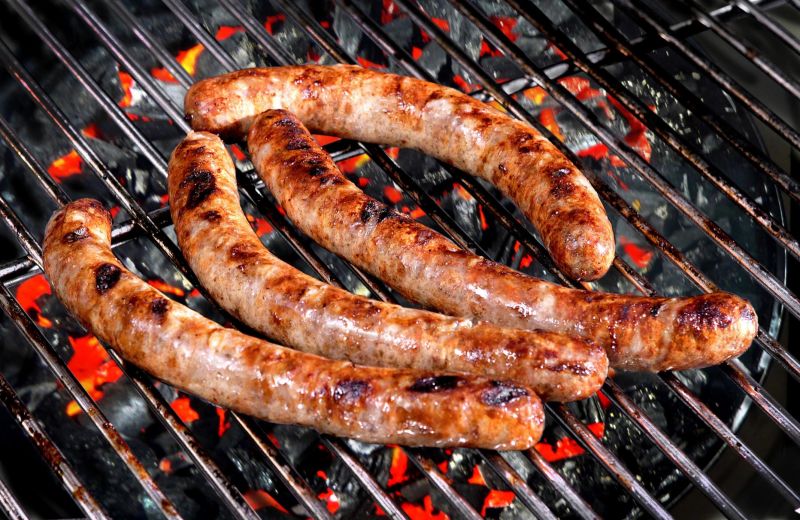
There is no Germany without sausages.
There are countless cured, smoked and other varieties available across wurst-loving Germany, so, for this list we will focus on some of the best German street food: bratwurst, or fried sausages.
There are more than 40 varieties of German bratwurst. Fried on a barbecue or in the pan, and then served in a white bread roll with mustard on the go, or with potato salad or sauerkraut as the perfect accompaniment for German beer.
Some of the most common bratwurst are:
– Fränkische bratwurst from Fraconia with marjoram as a characteristic ingredient.
– Nürnberger rostbratwurst that is small in size and mostly comes from the grill.
– Thüringer rostbratwurst from Thuringia, which is quite spicy. Thuringia is also the home of the first German bratwurst museum, which opened in 2006.
The most popular incarnation of bratwurst, however, is the next item on our list.
Practically synonymous with German cuisine since 1945, currywurst is commonly attributed to Herta Heuwer, a Berlin woman who in 1949 managed to obtain ketchup and curry powder from British soldiers, mixed them up and served the result over grilled sausage, instantly creating a German street food classic.
Today boiled and fried sausages are used, and currywurst remains one of the most popular sausage-based street foods in Germany, especially in Berlin, Cologne and the Rhine-Ruhr, where it’s usually served with chips and ketchup or mayonnaise or a bread roll.
Not the most sophisticated of dishes, but a filling street snack born out of necessity about which all of Germany is still mad: some 800 million are consumed a year.
Döner kebab was introduced to Germany by Turkish immigrant workers coming here in the 1960s and ’70s. One of the earliest street sellers was Kadir Nurman, who started offering döner kebab sandwiches at West Berlin’s Zoo Station in 1972, from the where the dish first took both West and East Berlin by storm and then the rest of Germany.
From its humble Berlin beginnings when a döner kebab only contained meat, onions and a bit of salad, it developed into a dish with abundant salad, vegetables (sometimes grilled), and a selection of sauces from which to choose.
Veal and chicken spits are widely used as is the ever-popular lamb, while vegetarian and vegan versions are becoming increasingly common.
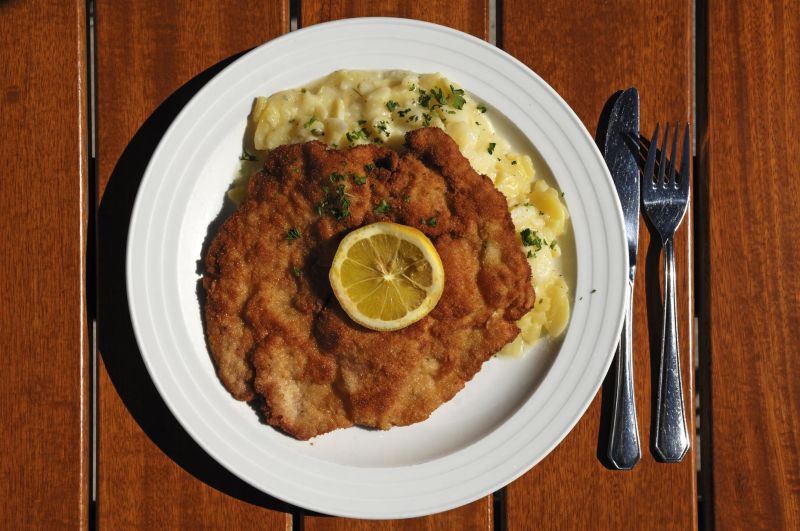
Some might argue that schnitzel is Austrian and not German, but its origins are actually Italian.
This controversy hasn’t stopped the breaded and fried meat cutlets to become popular everywhere in Germany, however. While the Austrian or Vienna schnitzel is by law only made with veal, the German version is made with tenderized pork or turkey and has become a staple of most traditional restaurants.
Whereas Vienna schnitzel is served plain, Germans love to ladle a variety of sauces over their schnitzel. Jägerschnitzel comes with mushroom sauce, zigeunerschnitzel with bell pepper sauce and rahmschnitzel is served with a creamy sauce.
All go well with fried potatoes and cold lager or a Franconian apple wine.
Spätzle originally come from Baden-Württemberg. Essentially a sort of pasta, the noodles are a simple combination of eggs, flour, salt and often a splash of fizzy water to fluff up the dough. Traditionally served as a side to meat dishes or dropped into soups, it can be spiced up by adding cheese: the käsespätzle variant is an extremely popular dish in southern Germany, especially Swabia, Bavaria and the Allgäu region.
Hot spätzle and grated granular cheese are layered alternately and are finally decorated with fried onions. After adding each layer, the käsespätzle will be put into the oven to avoid cooling off and to ensure melting of cheese. Käsespätzle is a popular menu item in beer gardens in summer and cozy Munich pubs in winter.
Rouladen is a delicious blend of bacon, onions, mustard and pickles wrapped together in sliced beef or veal. Vegetarian and other meat options are also now widely available but the real deal is rinderrouladen (beef rouladen), a popular dish in western Germany and the Rhine region.
This is a staple of family dinners and special occasions. They are usually served with potato dumplings, mashed potatoes and pickled red cabbage. A red wine gravy is an absolute requirement to round off the dish.
Sauerbraten is regarded as one Germany’s national dishes and there are several regional variations in Franconia, Thuringia, Rhineland, Saarland, Silesia and Swabia.
This pot roast takes quite a while to prepare, but the results, often served as Sunday family dinner, are truly worth the work. Sauerbraten (literally “sour roast”) is traditionally prepared with horse meat, but these days beef and venison are increasingly used.
Before cooking, the meat is marinated for several days in a mixture of red wine vinegar, herbs and spices. Drowned in a dark gravy made with beetroot sugar sauce and rye bread to balance the sour taste of the vinegar, sauerbraten is then traditionally served with red cabbage, potato dumplings or boiled potatoes.
This is another messy and not necessarily optically appealing dish, but nevertheless definitely worth trying. Himmel und erde, or himmel un ääd in Cologne (both mean “Heaven and Earth”) is popular in the Rhineland, Westphalia and Lower Saxony. The dish consists of black pudding, fried onions and mashed potatoes with apple sauce.
It has been around since the 18th century, and these days is a beloved staple of the many Kölsch breweries and beer halls in Cologne, where it goes perfectly well with a glass or three of the popular beer.
Germany’s most beautiful places
Zwiebelkuchen and federweisser
October is the month to taste the first wines of the year in Germany, and a well-known culinary treat in the south is federweisser und zwiebelkuchen (partially fermented young white wine and onion tart).
Federweisser literally means “feather white” and is made by adding yeast to grapes, allowing fermentation to proceed rapidly. Once the alcohol level reaches 4%, federweisser is sold. It is mostly enjoyed near where it is produced. Because of the fast fermentation, it needs to be consumed within a couple days of being bottled. In addition, the high levels of carbonation means that it cannot be bottled and transported in airtight containers.
In most towns and cities along the Mosel River, people flock to marketplaces and wine gardens in early October to sip a glass of federweisser and feast crispy, freshly made onion tarts called zwiebelkuchen. Because of its light and sweet taste, it pairs well with the savory, warm onion cake.
World politics in a pig’s stomach. Saumagen was made famous by former Chancellor of Germany Helmut Kohl, who (like the dish) hailed from the western Palatinate region. Kohl loved saumagen and served it to visiting dignitaries including 1980s British Prime Minister Margaret Thatcher, Soviet leader Mikhail Gorbachev and US Presidents Ronald Reagan and Bill Clinton.
The literal translation of this dish is “sow’s stomach,” but saumagen is a lot less curious than its name implies.
Somewhat resembling Scottish haggis, it is prepared by using the stomach of a pig (or an artificial one) as a casing for the stuffing made from pork, potatoes, carrots, onions, marjoram, nutmeg and white pepper.
It is then sliced and pan-fried or roasted in the oven, and, as Kohl knew, goes down perfectly well with sauerkraut, mashed potatoes and a dry white wine from the Palatinate.
Pinkel mit grünkohl, or cooked kale and sausage, is a delicious winter comfort food eaten mainly in northwest Germany, especially the region around Oldenburg, Bremen and Osnabrück as well as East Frisia and Friesland.
The cooked kale is mixed with mustard and bacon, and the “pinkel” sausage (named after the pinky) is made of bacon, groats of oats or barley, beef suet, pig lard, onions, and salt and pepper.
Germans sometimes celebrate winter with a traditional so-called “Grünkohlfahrt,” where family and friends go on a brisk hike accompanied by schnapps and finished off with a warm kale dinner in a country inn.
Germans are mad about white asparagus. As soon as harvest time arrives around mid-April, asparagus dishes appear on the menus of restaurants all over Germany, from Flensburg to Munich and Aachen to Frankfurt.
This is spargelzeit, the time of the asparagus, and it is celebrated with passion. During spargelzeit, the average German eats asparagus at least once a day. This adds up to a national total of over 70,000 tons of asparagus consumed per year.
No one can truly say where this fixation with white asparagus comes from, but the first document that mentions the cultivation of this vegetable around the city of Stuttgart dates to the 1686. There are spargel festivals, a spargel route in Baden-Württemberg and countless stalls along the roads of Germany selling the “white gold.”
In restaurants, asparagus is boiled or steamed and served with hollandaise sauce, melted butter or olive oil. It comes wrapped in bacon or heaped upon schnitzel; as asparagus soup, fried asparagus, pancakes with herbs and asparagus, asparagus with scrambled eggs or asparagus with young potatoes. There is an audible sigh all over Germany when spargelzeit ends on June 24, St. John the Baptist Day.
Fried potato pancakes are so popular in Germany that we have more than 40 names for them. They are known as reibekuchen, kartoffelpuffer, reibeplätzchen, reiberdatschi, grumbeerpannekuche and so on and so on.
Another quintessential German comfort and street food, reibekuchen are often served with apple sauce, on black pumpernickel rye bread or with treacle (a type of syrup).
They’re popular all year around: in Cologne and the Rhineland they are beloved of revelers during the Karneval festivities in spring, and all German Christmas markets have reibekuchen vendors where hundreds of litres of potato dough are being processed every day during the holiday season.
Why Germany is the bread capital of the world
Rollmöpse (plural) are cooked or fried and then pickled herring fillets, rolled around a savory filling like a pickled gherkin or green olive with pimento, and have been served on the coasts since medieval times.
Becoming popular during the early 19th century when the long-range train network allowed pickled food to be transported, Rollmöpse have been a staple snack on German tables ever since.
Rollmöpse are usually bought ready-to-eat in jars and are eaten straight, without unrolling, or on bread and sometimes with labskaus (see above). And like labskaus, they are commonly served as part of the German katerfrühstück or hangover breakfast.
Germany has a vast variety of cakes, but among the most popular is the Schwarzwälder kirschtorte or Black Forest gateau.
The cake is not named after the Black Forest mountain range in southwestern Germany, but the specialty liquor of that region, Schwarzwälder kirsch, distilled from tart cherries.
Allegedly created by Josef Keller in 1915 at Café Agner in Bonn in the Rhineland, it typically consists of several layers of chocolate sponge cake sandwiched with whipped cream and sour cherries, and then drizzled with kirschwasser. It is decorated with additional whipped cream, maraschino cherries and chocolate shavings.
Its popularity in Germany grew quickly and steadily after World War II, and it’s during this period that the kirschtorte starts appearing in other countries too, particularly on the British Isles.
Whatever the reason for its success, it is both perfect for kaffee und kuchen in a German cafe on a Sunday afternoon as well as dessert.
There are rarely any strawberries in German cheesecake (or any other fruits for that matter), and the base is surely not made from crackers but freshly made dough (or even without base, like in the East Prussian version).
The filling is made with low-fat quark instead of cream cheese and egg foam is added to give it more fluff, plus lemon and vanilla for some extra freshness.
Maybe this purity and the focus on a handful of ingredients is why a version of cheesecake exits in almost every region of Germany: there’s käsekuchen, quarkkuchen, matzkuchen and even topfenkuchen in Austria.
Wherever you try it, you can be sure that it is the perfect treat with some added fresh cream and a hot cup of coffee.
This dessert is another immigrant legacy and is popular with German children.
Spaghettieis is an ice cream dish made to look like a plate of spaghetti. Vanilla ice cream is pressed through a modified noodle press or potato ricer, giving it the appearance of spaghetti. It is then placed over whipped cream and topped with strawberry sauce representing the tomato sauce and white chocolate shavings for the Parmesan.
Besides the usual dish with strawberry sauce, there are also variations with dark chocolate ice cream and nuts available, resembling spaghetti carbonara instead of spaghetti bolognese.
Spaghetti ice cream was invented in 1969 by Dario Fontanella, son of an ice cream-making Italian immigrant in Mannheim, Germany. Thankfully for us and perhaps unfortunately for Dario, he didn’t patent his spaghetti ice cream and it is today available at almost every ice cream parlor anywhere in Germany.
Dario did, however, receive the “Bloomaulorden,” a medal bestowed by the city of Mannheim, for his culinary services in 2014.
Don't Miss
CNN — The escalating climate crisis is shifting many people’s purchasing patterns and this extends to the $500 billion dollar
CNN — With one of the world’s most diverse food scenes, China makes it nearly impossible to put together one
‘It felt electric from the time we took the field’: Tom Brady speaks about first NFL game in Germany Tom
Best Chinese food: 32 must-try dishes
CNN
—
With one of the world’s most diverse food scenes, China makes it nearly impossible to put together one single list that truly encompasses the “best” Chinese dishes.
But with such a huge variety of flavors on offer, it’s immensely helpful to go into the country with an introductory list of essential eats that will give you a well-rounded culinary experience.
Below are some of the can’t-miss dishes.
We have included both English and Chinese (Mandarin or Cantonese, depending how they are more commonly known) names in this story.

One bite into this small mountain of crispy duck skin, juicy meat, radish, cucumber, scallion and sweet bean sauce wrapped neatly in a thin pancake, and you’ll understand why Peking duck has been captivating stomachs – including those of ancient Chinese emperors – for centuries.
It’s said that roasted duck first started tantalizing taste buds more than 1,500 years ago in Nanjing, when the city was the seat of ancient Chinese imperial regimes.
The capital relocated to Beijing in the 1400s, and the imperial families brought those tasty roast duck recipes – and the chefs – with them.
It was there that the current way we enjoy the duck, wrapped in that delicate thin pancake, was invented and then popularized around the world.
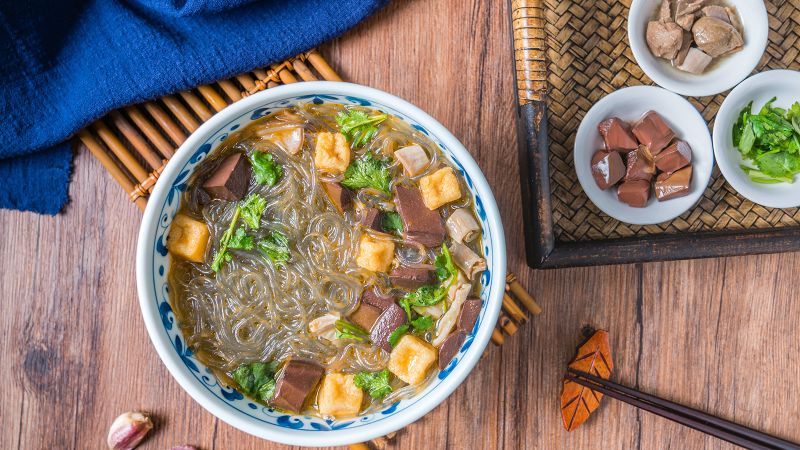
Many Nanjing residents will indeed tell you it’s their city – not Beijing – that’s the true duck capital of China.
The city’s obsession with the bird is evident in its wide array of duck offerings, including salted duck, pancakes made with duck grease and duck dumplings.
But nothing speaks to a duck lover’s heart quite like a cheap bowl of vermicelli soup with duck blood.
Made with duck-bone broth, duck blood curds and bits of duck offal, such as liver and gizzards, this street food dish fully utilizes every part of the bird to deliver incredibly intense flavors.
It may look simple, but steaming fish is a difficult art to master.
Timing is crucial. The number of minutes – or seconds – you should steam a fish is dictated by the type and size of a fish, as well as the strength of your own stove.
Undercook it by a minute, the flesh won’t detach from the bone; overcook it, the flesh will tighten too much and the fish will lose some of its moisture, tenderness and flakiness.
Cantonese steamed fish is usually served in some sweetened soy sauce and scallions.
It’s nearly impossible to dislike China’s soul-comforting dan dan mian, or dan dan noodles. The question is: Which version to try?
Dan dan noodles are named after the way they were originally sold more than 100 years ago – on a dan dan, a carrying pole, by street hawkers.
There are many ways to serve this famous Sichuan specialty. Some think dan dan noodles should contain a dry mix of noodles, made with minced meat, chopped scallions, spices, crushed peanuts and various sauces. Others disagree, preferring dan dan noodles in a hot, spicy, salty and nutty broth albeit with similar ingredients.
But most people would agree that dan dan noodles taste better when topped with a handful of rou saozi – finely chopped pork that’s been pan-fried in lard until golden brown and crispy.
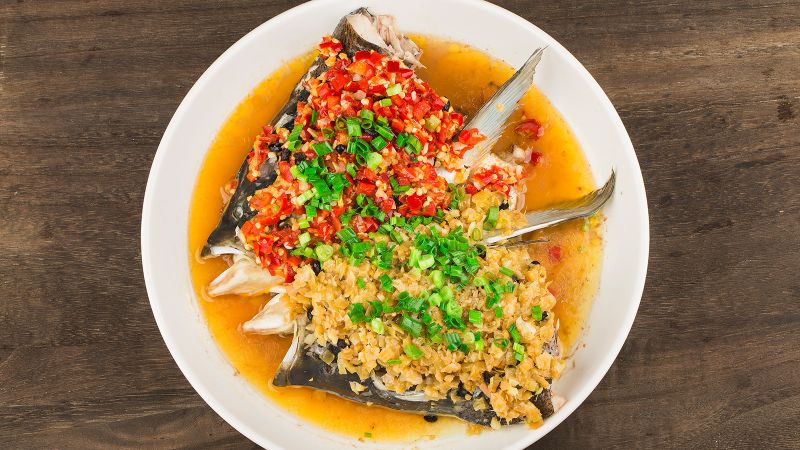
Cuisine in the mountainous, landlocked southern province of Hunan (also known as Xiang cuisine) is often cooked with a generous portion of oil, salt and chili.
The province even has its own chili-themed folk song, with lyrics proclaiming that “it doesn’t count as a dish if there is no chili. A touch of chili triumphs over an exquisite meal.”
No other dish represents Hunan cuisine as well as steamed fish heads served with chopped salted chili (duo jiao yu tou).
Duo jiao, a staple relish in Hunanese homes, is made with chili peppers that are dried, diced then preserved in a jar of salt, ginger, garlic and baijiu (Chinese liquor) for at least a week.
The thick blanket of duo jiao gives the steamed fish head a salty and spicy kick. The leftover juice is a delicious dip for noodles or dumplings after you’ve devoured the fish.
Warning: Once you’ve tried a Cantonese-style, woodfire oven-roasted goose, there’s no going back. No other goose dish will please your palate in quite the same way.
Upon hitting your mouth, the goose magically falls apart, offering an explosion of combined flavors from the crispy skin, melted fat and tender meat.
Some restaurants will use special types of wood, such as camphor wood or lychee wood, to give the bird a special smoky taste.
Seaside Chaozhou is known for no-frills seafood dishes that serve one purpose – to maximize the fresh ingredients’ original umami flavors.
Among the best dishes showcasing this style is Chaozhou-style cold fish or cold crab.
To preserve the freshness of the seafood, fish and crabs are lightly seasoned in salt before they’re steamed. They’re then cooled and served at room temperature.
The fish is often dipped in a special soy bean paste from Poling, while the crabs are served with a garlic and vinegar sauce.
Legend has it that cross-the-bridge rice noodles were invented many years ago by a loving wife. Her husband studied on an island, so the wife would travel across a bridge to deliver him his daily lunches.
As the food would be cold after the journey, the disheartened wife decided to bring a pot of scalding hot chicken broth, along with the rice noodles and raw ingredients.
It was an ingenious plan, really. The chicken oil on the surface of the soup would keep the liquid warm. When the husband was ready to eat, she’d cook all the ingredients by pouring them into the hot soup.
Today, many noodle shops offer their own style of cross-the-bridge rice noodles, offering a choice of different ingredients and soup bases.
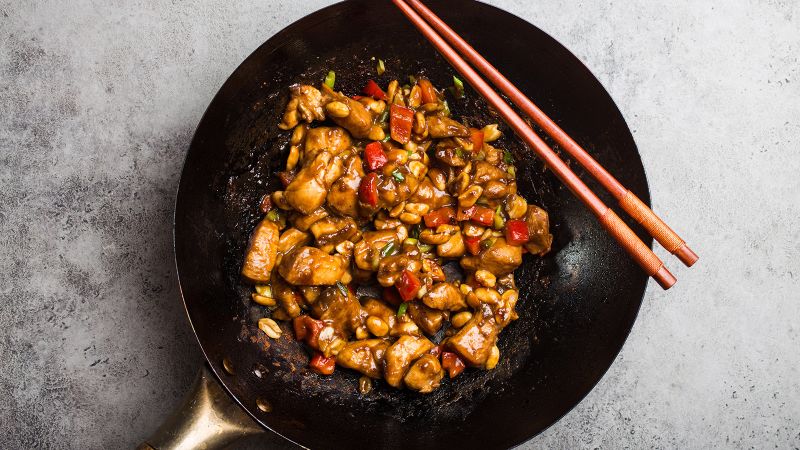
One of the most internationally famous Chinese dishes, Kungpao chicken is made by stir-frying diced chicken pieces with scallions, ginger, peppercorns, chili and deep-fried peanuts.
There are different origin stories, but many believe the dish was inspired by a former Sichuan governor in the 1800s called Ding Baozeng, whose nickname was Ding Gongbao – alternatively romanized as Kungpao.
It’s said that Ding loved a sour and salty fried chicken dish from China’s Shandong province. After he was relocated to Sichuan, he asked his chef to add some local chili and peanuts to the dish – and the rest is history.
Sweet and sour pork / Lychee pork
Deep-fried pork can feel a bit heavy, especially in unforgiving summer weather. Thankfully, we have sweet and sour pork.
The pineapple in the dish and a sauce made with sugar, vinegar and soy sauce add some freshness to the crispy pork.
If you’re a fan of sweet and sour pork, you should also try the Fujian version of the dish – lychee pork. By incising the surfaces of the pork pieces, they resemble lychees’ uneven skins after being deep-fried.
There is no lychee in the dish traditionally – the sweetness comes from sugar, but some restaurants add lychee or use lychee sauce to match its name.
Bonus: The rugged surfaces on the pork hold more sauce and have a more tender texture.
Who needs French fries when you have dumplings?
Whether you love them steamed, boiled or pan-fried, jiaozi pack a full punch of carbs, proteins and vegetables in one mouthful.
Vinegar and chili oil are some of the best condiments to go with Chinese dumplings.
One of the most interesting styles of dumplings is Fujian’s rouyan version – delicious enough to earn their own spot on this list.
The mini pork dumplings have an extra chewiness to them as their wrappers are made of pork and some flour.
While Hainanese chicken rice isn’t actually from China’s Hainan province (it was first served in Malaysia), the dish was inspired by the tropical island province and its famous Wenchang chicken.
Made with a special breed of poultry from the island’s eponymous city, Wenchang chicken is prized for its thin skin, tender meat and sweet flavor.
The most common way to cook a Wenchang chicken is by blanching and air drying it. Similar to Hainanese chicken rice, the Wenchang version is often served with yellow chicken fat rice and chicken soup.
Hainan locals usually prefer garlic and ginger paste, chili sauce and the juice of small tangerines as condiments.
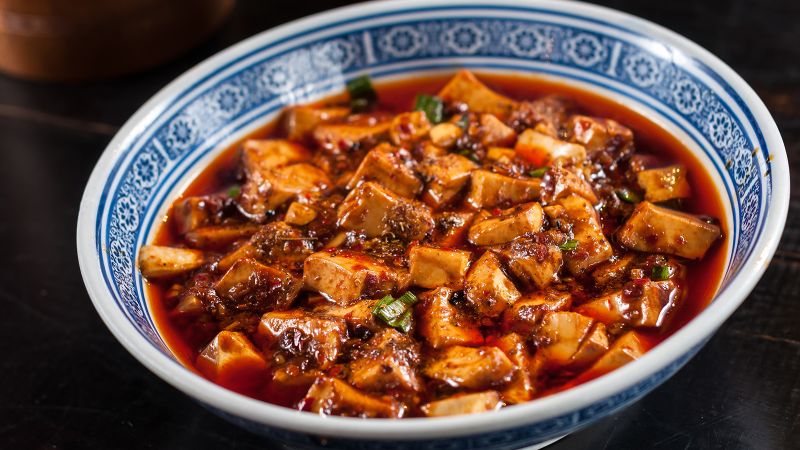
A memorable mapo tofu packs a boatload of zing – salty, peppery and spicy flavors should all hit the taste buds in a single spoonful thanks to the different types of spices, peppers and chili used in the dish.
Discerning local gourmets insist that the best mapo tofu should be made with Hanyuan peppercorns and broad bean chili paste from Sichuan’s Pidu district.
It’s most commonly cooked with minced pork or beef – and tofu, of course. But as the Sichuan dish is so wildly popular nowadays, restaurants often serve creative versions of mapo tofu with different types of meats.
Tender, well-braised pork belly is naturally irresistible – but the star of this Hakka dish is actually mei cai, a dry, pickled Chinese mustard that gives the hearty stew its sour and salty taste.
It’s said that every Hakka family, a traditionally nomadic tribe in China, pickle their own mei cai.
When they make too much of it, they will whip up a mei cai relish that’s a great topping for plain rice and noodles.
Whether it’s an elevated version made with diced abalone and truffles, or a leftover medley of soon-to-spoil ingredients from your fridge, every good version of classic fried rice shares two important ingredients – dry but succulent rice and wok hei (also known as the breath of the wok).
One of the most welcome sights on a cold morning in Tianjin in northern coastal China is a jian bing stand, with its sizzling hot pan.
Jian bing guozi is composed of two elements: Jian bing (crepes) and guozi (deep-fried crisps).
To make a jian bing guozi, first, a mung bean mixture is fanned out with a ladle onto a flat-iron pan. Eggs and scallions are then spread out on the crepe.
After the pancake is flipped over, a dollop of bean paste, sheets of guozi crisps (or, sometimes, deep-fried breadsticks and vegetables) are added before the vendor – usually an elderly man – folds the stuffed and toasted pancake and hands it to you in a paper bag.
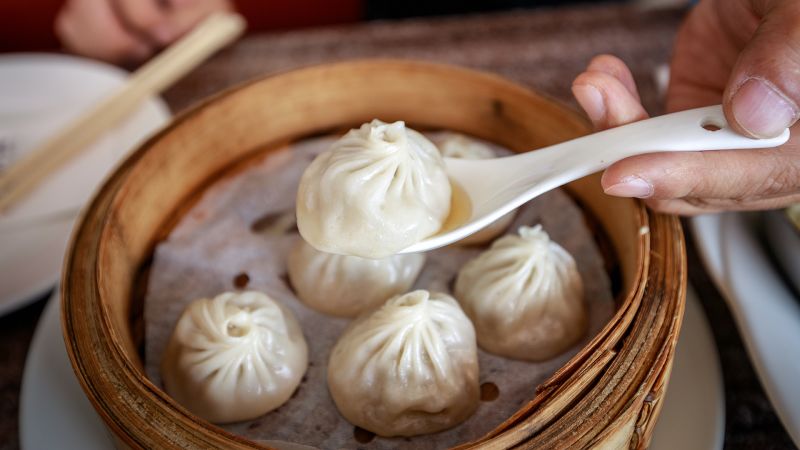
Wondering whether the xiaolongbao wrapper will break on the long journey between the steaming basket and your mouth is one of the most suspenseful moments that can take place at a dining table.
Amassing a huge following in and outside China, xiaolongbao, also called xiaolong tangbao (translated as “small basket soup bun”), is a mix of soup and pork packed inside a thin dumpling wrapper.
In addition to pork, the soupy dumplings can also be filled with crab meat and crab roe.
If you’re one of those people who thinks the real star of beef chow fun is the noodles and not the beef, you should try Chen cun fen (Chen village flat rice noodles).
Chewier, wider and thinner than the usual flat rice noodles, Chen cun fen is a specialty from Chen village, a town in Shunde district in the Pearl River Delta.
In addition to being stir-fried in a noodle dish, the semi-translucent and smooth Chen cun fen make a great base layer for dishes such as steamed spareribs and seafood as the noodles absorb all the flavors from the other ingredients.
Named after famous poet, painter and statesman Su Dongpo (who lived about 1,000 years ago), Dongpo rou is made up of braised pork belly, rock sugar, soy sauce, yellow wine and other seasonings.
The result is a richly flavored and extremely tender pork slab that can easily be pried apart with chopsticks.
It’s a delicious dish that goes well with steamed white rice.
Hot and sour soup
Surprisingly, China’s famed hot and sour soup isn’t just great at warming up your body in winter.
Local Sichuanese believe that the soup can also expel excessive humidity and hotness from one’s body in summer as well.
A bowl of hot and sour soup should have a balance of sourness (from vinegar) and spiciness (from peppers) – but not hotness from chili.
Shreds of tofu, Chinese mushrooms, wood ears and bamboo shoots are some of the common ingredients found in the thick soup.
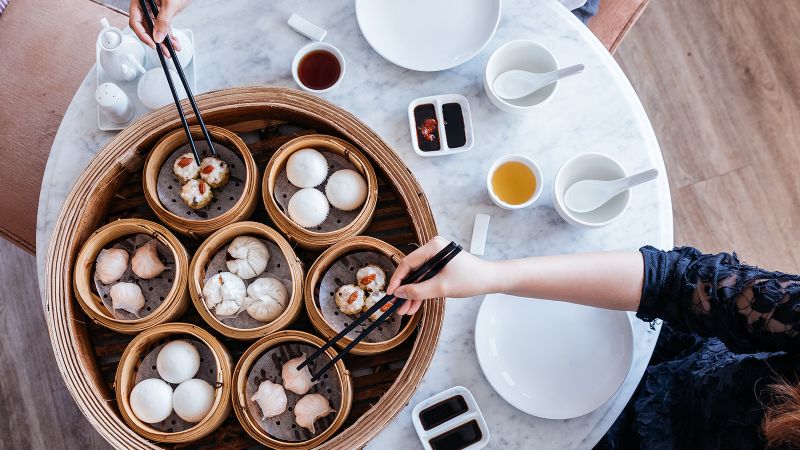
Dim sum refers more to a style of serving food – it’s a type of meal in Cantonese food culture – rather than a specific dish.
It’s a cunning way to include many different varieties of small plates – from pan-fried radish cake to prawn dumplings to siu mai – in one meal.
At the same time, dining on a combination of these dishes during a dim sum session is far more enjoyable than eating just one version on its own.
Don’t be fooled by its bland-sounding Chinese name – shui zhu, which translates literally to “water boil.”
Shui zhu is a cooking technique that was first developed in Sichuan cuisine. The word water (shui) refers to the hot, spicy chili oil broth that is used to poach thinly sliced beef (shui zhu niu), pork (shui zhu roupian) or fish (shui zhu yu).
Today, the photogenic crowd-pleaser is often served with sliced celtuce (a type of lettuce) and flat mung bean noodles in the broth, too.
The best barbecue pork should be slightly charred on the outside and contain just the right amount of sweetness and saltiness from the maltose, wine and soy sauce.
A Cantonese roast shop will let you choose the level of fattiness you want in your char siu, Cantonese for barbecue pork.
Half lean, half fatty char siu is the go-to option if you are a newbie.
Barbecue pork is a highly versatile ingredient served in many delicious dishes – from char siu macaroni soup for breakfast to char siu bao – steamed buns –– at dim sum.
Bao – a steamed bread roll filled with a variety of ingredients including meat or vegetables – come in many shapes and sizes.
It could be a plain bao with a glossy and smooth exterior (mantou), or an oversized steamed volcano-shaped bao stuffed with an entire meal’s worth of food (da bao, or translated as “big bao”).
But one of the best baos is undoubtedly sheng jian bao.
The pan-fried bao is filled with pork and broth, while scallions and white sesame seeds are sprinkled on top.
The Mausoleum of Terracotta Warriors is usually the reason travelers visit Xi’an, but this western Chinese city’s delicious and similarly historical rou jia mo is another great reason to head there.
The ubiquitous street eat consists of a grilled mo (flat bread) and an overflowing amount of shredded pulled pork belly that has been braised in soy sauce, rock sugar and spices such as cinnamon, star anise, cloves and peppercorns for hours.
Undercooked mo is a big no-no. A common saying in Shaanxi province goes “tie quan hu bei juhua xin,” which means “iron ring, tiger’s back and chrysanthemum’s heart ” – the perfect patterns you should look for on a well toasted mo.
Cantonese parents are the real experts when it comes to therapeutic herbal soups, which are simmered for hours to infuse the liquid with healing qualities and deliciousness.
Various seasonal ingredients offer different cooling or warming qualities to restore balance in the body.
For example, apple, snow fungus and lily petal soup will hydrate your body, whereas winter melon and barley soup will cool you down in hot weather.
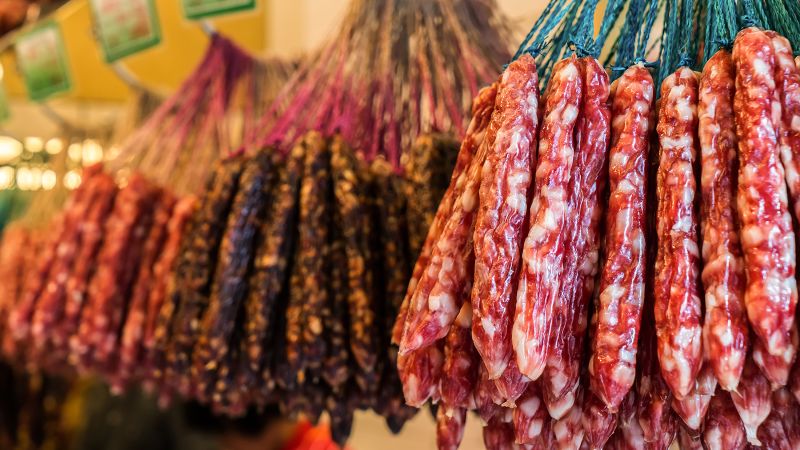
The Chinese version of salami is often categorized into two main types: Laap cheung and yun cheung (in Cantonese).
Laap cheung is preserved meat sausage that has a slightly sweet taste. Yun cheung, on the other hand, is mostly made with offal from poultry, giving it a stronger and gamier flavor.
Unlike their European counterparts, Chinese preserved sausages should be steamed before eaten.
You can find them wrapped in buns, stir-fried with sticky rice or steamed in a clay pot.
The secret to a delicious Fujian-style taro paste is binlang yu, a special breed of yam from Fujian’s Fuding county. The white and purple flesh of a binlang yu has vibrant fragrances and an earthy, nutty and sweet taste.
To make the dessert, the taro is cooked and mashed before it’s mixed with sugar and lard.
The thick, silky taro mash will then be garnished with sweet toppings such as dates, candied cherries and gingko.
When it comes to nourishing your digestive system, in sickness and in health, it’s all about congee (porridge, commonly made with rice).
A popular breakfast item in many parts of China, the versatile cheap eat can be served plain with a drizzle of soy sauce and scallions, or stewed with savory ingredients such as chicken or fish.
Lean pork floss and century egg congee is one of the classics served in the south of China. Congee made with millet instead of rice and flavored with pumpkin is popular in the north.
Those who are extra hungry can order a side of soy sauce-fried noodles, deep-fried breadsticks (youtiao) or soy milk. These can be enjoyed on the side, or you can tear up the breadsticks or add some noodles to the congee.
Most people who visit Chaozhou can’t resist picking up a family-sized bag of super bouncy and flavorsome meat balls made of beef beaten by hand to bring home with them.
Highly praised for their understanding of beef, Chaozhou people are also famous for other dishes such as beef hot pot.
One of the most loved desserts in China, sweet rice balls, or tangyuan, can be found in many regions.
Ningbo is one of the best places to sample these round mochi-like desserts.
The soft, pillowy exterior is made with sticky rice while the filling is made of black sesame, sugar and lard.
The lard gives the filling an extra fragrance and sheen.
Don't Miss
CNN — The escalating climate crisis is shifting many people’s purchasing patterns and this extends to the $500 billion dollar
CNN — Hong Kong is widely considered one of the most challenging cities in the world to operate a restaurant
To tackle Thailand’s mounting trash problem, one company is turning to the country’s plant life. Universal Biopack makes packaging that
Virgin Boeing 747 to launch rocket into space
CNN
—
At the far southwestern tip of England, dangling into the Atlantic, the remote region of Cornwall rarely feels like the center of the world.
But recently locals have been feeling tantalizingly close as they’ve watched a very special plane fly low overhead, taking off from the runway at little Newquay Airport – the 29th biggest airport in the UK – and circling the skies above the coast before touching back down.
This isn’t just any plane. Nor is it a normal Boeing 747, as it appears from the ground. In fact, it’s the “Queen of the Skies” repurposed for the space race, making trial flights before it takes part in the United Kingdom’s first orbital space launch next month. And it’ll be taking off from Spaceport Cornwall, which shares the airport’s 1.7-mile regular runway.
Marc Andrew, from nearby Newquay, traveled to the spaceport after work to see the aircraft land this week.
“It was amazing to watch, and will be a nice bit of history to tell my little boy when he’s older,” he told CNN. He is now preparing to return for the November launch.
Cosmic Girl, as the plane has been named, is the vessel for Virgin Orbit’s bid to launch seven satellites into space.
A former passenger jumbo jet in service with Virgin Atlantic until 2015, it has been modified to carry LauncherOne, a California-made rocket which will go into the Earth’s orbit.
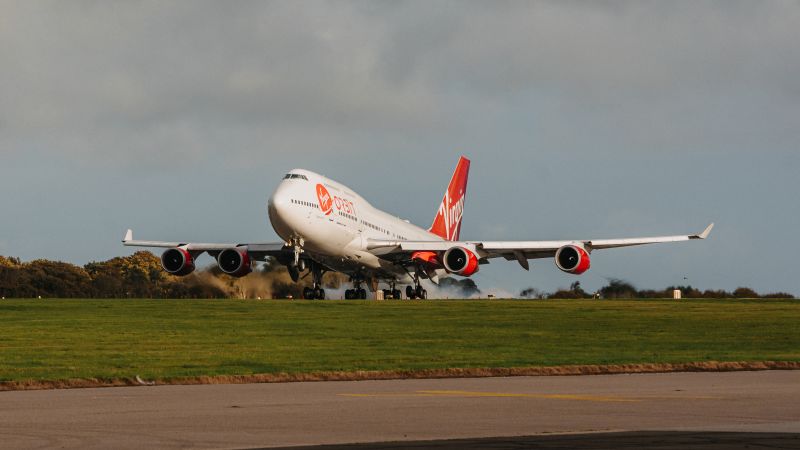
Next month, Cosmic Girl will take off from Newquay’s clifftop runway with LauncherOne under its wing – and once the 747 hits 34,000 feet, it’ll release the rocket.
Inside will be seven payloads, or satellites, which will start circling the planet in low Earth orbit.
A trial last year saw the rocket – released from under the 747’s left wing – traveling at up to 17,000 miles an hour as it zoomed into space.
Using a 747 for a horizontal launch enables a “broader range of orbits than would be possible from a traditional ground-launched system,” Virgin Orbit wrote in a statement.
The event will be the first orbital space launch for the UK and the first international launch for Virgin Orbit, according to the company. It’ll also be Europe’s first satellite launch, according to Ian Annett, deputy CEO at the UK Space Agency.
LauncherOne completed its first full launch rehearsal in Long Beach, California, on October 2, before being flown to the UK last Friday to meet Cosmic Girl, which arrived in Cornwall on October 11.
Cosmic Girl completed a nearly three-hour test flight around Cornwall and Southwest England on October 14, with Cornwall locals noting it flying low over their gardens.

Virgin Orbit’s chief pilot, Matthew Stannard, who will fly the 747 for the launch, said: “It feels amazing to bring Cosmic Girl home to the UK We are weeks away now from the first UK launch at Spaceport Cornwall so it’s all very real.”
Melissa Thorpe, head of Spaceport Cornwall, said: “Seeing the infrastructure in place makes our launch ambitions a reality.”
Hoping to see more Cosmic Girls? Virgin Orbit is planning to bring horizontal launches to Australia, Brazil, Japan, Poland and the Republic of Korea.
Don't Miss
Story highlights Astronauts can temporarily gain 2 inches in height but suffer muscle loss and back pain More countermeasures involving
Turn Your Rising Home Equity Into Cash You Can Use Source link
Story highlights Shane Kimbrough is a NASA astronaut He voted in the 2016 election CNN — From infinity and beyond,





